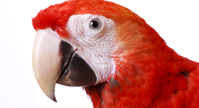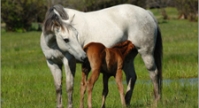M-Locus Merle (Merle / Cryptic Merle)
Description:
Merle is a coat pattern found in Australian Shepherds, Collies, Shelties, and a number of other dog breeds. This particular phenotype is inherited as an autosomal, incompletely dominant trait. The merle gene creates mottled patches of color in a solid or piebald coat, blue or odd-colored eyes, and affects skin pigment. Animals that are “double merle,” a common term used for dogs that are homozygous (having two copies) of the merle (M/M) trait, are predominantly white and prone to several health issues.
The chances of having puppies that develop health issues increase when two merles are bred together. It is recommended that a merle dog only be bred to a non-merle/non-cryptic Merle dog. Cryptic merle dogs do not appear to be merle, but contain the merle gene. Many solid dogs are actually cryptic, also known as phantom, merles and can produce both merle and double merles if not careful.
Merle can affect all coat colors. Recessive red dogs can also be affected by merle, but the patches are either hardly seen or (if the dog is a clear, recessive red) are not visible at all. Combinations such as brindle merle exist, but are not typically accepted in breed standards.
In addition to altering base coat color, merle also modifies eye color and the coloring of the nose and paw pads. The merle gene modifies the dark pigment in the eyes, occasionally changing dark eyes to blue, or only part of the eye to blue. Since Merle causes random modifications, both dark-eyed, blue-eyed, and odd-colored eyes are possible. Color on paw pads and nose may be mottled pink and black.
Genetics:
If two carriers (M/m) are bred with one another, there is a 25% chance per puppy born that they will be homozygous (M/M) for the merle trait. These are also known as "double merles." A high percentage of double merle puppies have vision or hearing deficiencies.
A cryptic or phantom merle is a dog which phenotypically appears to be a non-merle (solid-colored) or a dog that has very faint patches of merle that can go unnoticed. Animals that do not present the merle phenotype may possess the merle genotype and subsequently produce merle offspring. These animals are known as cryptic merles, as they don't appear to be merle but can produce merles.
Sample Type:
Animal Genetics accepts buccal swab, blood, and dewclaw samples for testing. Sample collection kits are available and can be ordered at Canine Test Now.
Testing Is Relevant for the Following Breeds:
All Dog Breeds , American Cocker Spaniel , Australian Shepherd , Border collie , Cardigan Welsh Corgi, Chihuahua , Dachshund , Old English Sheepdog (Bobtail), English Bulldog, French Bulldog, Great Dane, Shetland Sheepdog (Sheltie), Rough Collie, Smooth Collie, Pomeranian, Pyrenean Shepherd, Bobtail, American Staffordshire Terrier, Hungarian Mudi, Catahoula Leopard Dog, Norwegian Dunker, Beauceron, Bergamasco.
Results:
Animal Genetics offers DNA testing for (PMEL17) mutation. The genetic test verifies the presence of the mutation and presents results as one of the following:
| M/M | Double Merle | Dog carries two copies of the dominant "M" allele. The dog is considered an affected, "double Merle" because M/M dogs can be affected by deafness and ocular defects. M/M dogs will always pass on a copy of Merle to their offspring. |
| M/m | Merle | Dog has one copy of the "M" Merle allele and one negative "m" copy of Merle allele. The dog can pass either allele on to any offspring. |
| m/m | Negative | Dog has two copies of the recessive "m" allele and is negative for Merle. The dog will always pass on a negative copy of the Merle allele to all offspring. |
| CR/CR | Double Cryptic | Dog carries two copies of the Cryptic "CR" allele. |
| m/CR | Merle | Dog has one copy of the Cryptic "CR" allele and one negative "m" copy of Merle allele. The dog can pass either allele on to any offspring. |
| m/m | Negative | Dog is negative for Cryptic "C" allele. The dog will always pass on a negative copy of the Merle allele to all offspring. |
| CR/CR | Double Cryptic | Dog carries two copies of the Cryptic "CR" allele. |
| m/CR | Merle | Dog has one copy of the Cryptic "CR" allele and one negative "m" copy of Merle allele. The dog can pass either allele on to any offspring. |
| m/m | Negative | Dog is negative for Cryptic "C" allele. The dog will always pass on a negative copy of the Merle allele to all offspring. |
| M/CR | Merle/Cryptic | Dog carries one copy of the dominant "M" allele and one Cryptic Merle allele. The dog is considered a Merle, and caries Cryptic Merle. The dog can pass either allele on to any offspring |
References:
BMC Vet Res. 2006 Feb. 27;2:9. Coat colour in dogs: identification of the Merle locus in the Australian shepherd breed. Hédan B1, Corre S, Hitte C, Dréano S, Vilboux T, Derrien T, Denis B, Galibert F, Galibert MD, André C.
Submit a Sample for Testing:
To submit a sample for testing please go to Canine Test Now.
To order a sample collection kit please go to Order Sample Collection kits.
Cost per sample is $40.00. Please see our Canine Fee Schedule for all test rates.










